Geochemical Characteristics and the Sedimentary Environment of Lower Cambrian Argillaceous Rocks on the Kongquehe Slope, Tarim Basin, China
Abstract
:1. Introduction
2. Geological Settings
3. Samples and Methods
4. Results
4.1. Major Elements
4.2. Trace Elements
4.3. REE

| Sample | Xishanbulake Formation (n = 6) | Xidashan Formation (n = 15) | |||||||||||||||||||
|---|---|---|---|---|---|---|---|---|---|---|---|---|---|---|---|---|---|---|---|---|---|
| S1-1 | S1-2 | S1-3 | S1-4 | S1-5 | S1-6 | S2-1 | S2-2 | S2-3 | S2-4 | S2-5 | S2-6 | S2-7 | S2-8 | S2-9 | S2-10 | S2-1 | S2-12 | S2-13 | S2-14 | S2-5 | |
| SiO2 | 89.58 | 94.35 | 4.43 | 77.55 | 67.09 | 80.41 | 31.70 | 82.02 | 72.72 | 87.69 | 82.25 | 63.59 | 82.81 | 79.58 | 78.96 | 73.37 | 83.38 | 53.22 | 85.91 | 63.67 | 72.62 |
| Al2O3 | 1.03 | 0.76 | 0.81 | 2.90 | 3.88 | 3.45 | 2.21 | 5.20 | 5.97 | 3.56 | 7.03 | 9.57 | 5.82 | 7.15 | 6.38 | 7.94 | 5.08 | 5.70 | 2.37 | 4.55 | 5.05 |
| Fe2O3 | 1.22 | 1.10 | 0.38 | 2.85 | 2.62 | 1.63 | 36.27 | 1.92 | 3.39 | 1.56 | 1.88 | 5.77 | 2.07 | 2.68 | 3.35 | 3.80 | 2.19 | 2.54 | 1.74 | 3.09 | 2.66 |
| MgO | 0.25 | 0.14 | 15.56 | 0.41 | 0.67 | 0.62 | 0.32 | 0.63 | 0.58 | 0.41 | 0.63 | 0.87 | 0.60 | 0.68 | 0.57 | 0.69 | 0.57 | 4.97 | 0.50 | 4.52 | 2.32 |
| CaO | 1.79 | 0.58 | 31.86 | 0.83 | 3.80 | 1.03 | 0.58 | 0.64 | 0.26 | 0.46 | 0.38 | 0.40 | 0.40 | 0.41 | 0.38 | 0.44 | 0.58 | 11.69 | 2.13 | 7.02 | 3.99 |
| Na2O | 0.15 | 0.15 | 0.20 | 0.30 | 0.35 | 0.13 | 0.11 | 0.15 | 0.18 | 0.11 | 0.16 | 0.23 | 0.14 | 0.15 | 0.15 | 0.17 | 0.21 | 0.29 | 0.15 | 0.40 | 0.35 |
| K2O | 0.21 | 0.15 | 0.11 | 0.68 | 0.99 | 0.93 | 0.63 | 1.41 | 1.64 | 0.94 | 1.60 | 2.78 | 1.56 | 1.96 | 1.91 | 2.47 | 1.38 | 1.55 | 0.54 | 1.18 | 1.32 |
| MnO | 0.04 | 0.02 | 0.29 | 0.03 | 0.04 | 0.02 | 0.03 | 0.01 | 0.03 | 0.02 | 0.02 | 0.02 | 0.01 | 0.02 | 0.01 | 0.01 | 0.01 | 0.03 | 0.02 | 0.02 | 0.01 |
| Ti O2 | 0.04 | 0.03 | 0.03 | 0.16 | 0.23 | 0.20 | 0.14 | 0.30 | 0.50 | 0.19 | 0.35 | 0.82 | 0.29 | 0.41 | 0.34 | 0.46 | 0.23 | 0.35 | 0.09 | 0.22 | 0.27 |
| P2O5 | 0.04 | 0.03 | 0.73 | 0.18 | 0.15 | 0.18 | 0.03 | 0.08 | 0.05 | 0.05 | 0.06 | 0.06 | 0.05 | 0.05 | 0.05 | 0.07 | 0.04 | 0.09 | 0.02 | 0.04 | 0.05 |
| FeO | 1.01 | 0.91 | 0.32 | 1.32 | 1.45 | 1.18 | 2.58 | 1.17 | 1.38 | 1.11 | 0.82 | 1.47 | 1.29 | 1.16 | 1.02 | 1.04 | 0.50 | 0.83 | 0.76 | 0.85 | 0.62 |
| LOI | / | / | / | / | / | / | / | / | / | / | / | 15.38 | 5.67 | 6.30 | 7.52 | 9.99 | 6.05 | 18.42 | 5.96 | 14.72 | 10.79 |
| CaO* | 1.67 | 0.49 | 29.41 | 0.25 | 3.30 | 0.42 | 0.47 | 0.39 | 0.10 | 0.30 | 0.17 | 0.20 | 0.25 | 0.23 | 0.21 | 0.21 | 0.46 | 11.40 | 2.05 | 6.88 | 3.82 |
| CIA | 33.69 | 49.02 | 2.64 | 70.28 | 45.54 | 69.94 | 64.65 | 72.74 | 75.69 | 72.63 | 78.51 | 74.84 | 74.90 | 75.34 | 73.75 | 73.64 | 71.26 | 30.09 | 46.39 | 34.97 | 47.93 |
| PIA | 31.11 | 48.78 | 2.30 | 80.32 | 44.19 | 82.03 | 73.09 | 87.55 | 93.99 | 86.63 | 94.36 | 93.95 | 91.61 | 93.18 | 92.52 | 93.62 | 84.69 | 26.19 | 45.41 | 31.63 | 47.24 |
| ICV | 3.48 | 2.75 | 57.12 | 1.61 | 2.11 | 1.15 | 17.18 | 0.92 | 1.08 | 0.99 | 0.68 | 1.12 | 0.85 | 0.86 | 1.03 | 0.98 | 0.99 | 3.71 | 2.14 | 3.58 | 2.13 |
| Sample | Xishanbulake Formation (n = 6) | Xidashan Formation (n = 15) | UCC | |||||||||||||||||||
|---|---|---|---|---|---|---|---|---|---|---|---|---|---|---|---|---|---|---|---|---|---|---|
| S1-1 | S1-2 | S1-3 | S1-4 | S1-5 | S1-6 | S2-1 | S2-2 | S2-3 | S2-4 | S2-5 | S2-6 | S2-7 | S2-8 | S2-9 | S2-10 | S2-1 | S2-12 | S2-13 | S2-14 | S2-15 | ||
| Li | 6.14 | 5.87 | 2.07 | 18.40 | 15.80 | 10.10 | 4.36 | 9.66 | 11.30 | 8.69 | 11.30 | 15.60 | 9.14 | 11.70 | 11.20 | 18.90 | 9.89 | 17.70 | 8.79 | 12.20 | 13.70 | 20.00 |
| Be | 0.43 | 0.35 | 1.74 | 3.90 | 1.18 | 1.03 | 0.54 | 1.21 | 1.46 | 0.84 | 1.50 | 2.30 | 1.49 | 1.80 | 1.46 | 1.92 | 1.07 | 1.59 | 0.59 | 1.10 | 1.23 | 3.00 |
| V | 239.00 | 399.00 | 120.00 | 1708.00 | 982.00 | 2419.00 | 885.00 | 1819.00 | 1790.00 | 851.00 | 1191.00 | 1013.00 | 645.00 | 332.00 | 389.00 | 216.00 | 687.00 | 180.00 | 503.00 | 559.00 | 132.00 | 60.00 |
| Cr | 46.10 | 32.60 | 14.90 | 107.00 | 83.40 | 111.00 | 75.20 | 91.40 | 140.00 | 53.10 | 74.90 | 113.00 | 51.20 | 62.80 | 43.60 | 54.90 | 42.60 | 48.60 | 39.00 | 43.70 | 34.20 | 355.00 |
| Co | 2.33 | 1.76 | 1.31 | 7.83 | 7.05 | 4.83 | 3.98 | 5.64 | 10.50 | 4.07 | 6.58 | 18.30 | 6.73 | 9.75 | 6.80 | 12.80 | 5.73 | 10.70 | 3.61 | 9.73 | 11.40 | |
| Ni | 37.20 | 38.50 | 22.30 | 132.00 | 176.00 | 193.00 | 221.00 | 109.00 | 172.00 | 56.10 | 60.70 | 180.00 | 71.70 | 66.60 | 96.60 | 51.90 | 86.80 | 40.30 | 102.00 | 98.60 | 40.20 | 20.00 |
| Cu | 21.90 | 18.00 | 9.75 | 260.00 | 81.50 | 39.40 | 245.00 | 47.20 | 79.00 | 29.80 | 60.30 | 126.00 | 35.40 | 59.60 | 29.50 | 61.60 | 30.30 | 38.40 | 24.00 | 44.50 | 51.40 | 25.00 |
| Zn | 59.00 | 46.70 | 22.10 | 2070.00 | 121.00 | 242.00 | 281.00 | 579.00 | 949.00 | 175.00 | 644.00 | 283.00 | 106.00 | 84.90 | 186.00 | 50.50 | 132.00 | 45.20 | 128.00 | 60.80 | 28.00 | 71.00 |
| Ga | 1.63 | 1.22 | 0.92 | 18.80 | 5.95 | 5.70 | 3.80 | 8.71 | 10.20 | 5.48 | 9.47 | 14.90 | 9.12 | 11.00 | 9.90 | 11.60 | 7.34 | 8.77 | 3.44 | 6.64 | 7.27 | 17.00 |
| Rb | 7.43 | 5.11 | 3.54 | 22.00 | 34.90 | 34.80 | 23.40 | 52.40 | 63.50 | 33.70 | 57.90 | 101.00 | 56.30 | 66.90 | 60.80 | 77.50 | 46.00 | 54.10 | 19.10 | 44.20 | 45.60 | 112.00 |
| Sr | 71.00 | 29.80 | 800.00 | 91.60 | 145.00 | 48.60 | 34.00 | 40.30 | 28.80 | 30.50 | 33.40 | 39.50 | 32.80 | 34.70 | 32.00 | 38.30 | 33.10 | 229.00 | 106.00 | 129.00 | 127.00 | 350.00 |
| Y | 4.44 | 2.73 | 23.30 | 23.50 | 30.60 | 29.20 | 7.87 | 14.60 | 21.70 | 7.80 | 11.50 | 20.30 | 7.05 | 8.60 | 7.98 | 12.80 | 5.48 | 17.20 | 4.64 | 11.40 | 9.75 | 22.00 |
| Mo | 21.60 | 18.80 | 15.10 | 300.00 | 95.70 | 78.60 | 34.30 | 53.90 | 77.80 | 28.30 | 28.10 | 141.00 | 43.10 | 53.30 | 46.20 | 76.40 | 38.50 | 20.30 | 27.00 | 48.60 | 32.10 | 1.50 |
| Ba | 460.00 | 444.00 | 1168.00 | 1888.00 | 1640.00 | 1705.00 | 1048.00 | 2622.00 | 2311.00 | 2309.00 | 3052.00 | 3217.00 | 3936.00 | 3645.00 | 4256.00 | 4231.00 | 3179.00 | 2420.00 | 1316.00 | 2115.00 | 2055.00 | 50.00 |
| Sb | 1.40 | 0.93 | 0.75 | 34.20 | 7.57 | 3.57 | 51.70 | 6.11 | 12.90 | 5.20 | 9.57 | 9.06 | 2.22 | 1.98 | 1.43 | 2.80 | 1.63 | 2.25 | 0.78 | 2.14 | 1.02 | 0.20 |
| Cs | 0.68 | 0.45 | 0.25 | 1.97 | 2.68 | 2.81 | 1.67 | 3.69 | 4.31 | 2.31 | 3.78 | 6.28 | 3.45 | 4.07 | 3.81 | 4.98 | 3.04 | 3.46 | 1.33 | 2.62 | 3.13 | 4.90 |
| Tl | 0.34 | 0.30 | 0.17 | 3.15 | 2.26 | 2.85 | 13.90 | 2.79 | 3.85 | 1.77 | 1.93 | 6.29 | 2.49 | 2.65 | 2.84 | 3.24 | 1.79 | 1.78 | 1.30 | 1.51 | 1.56 | |
| Pb | 10.20 | 5.40 | 8.51 | 44.70 | 18.90 | 10.40 | 66.10 | 12.40 | 20.60 | 10.30 | 16.60 | 25.30 | 8.85 | 16.90 | 9.80 | 22.40 | 12.90 | 17.10 | 9.23 | 33.60 | 20.00 | 20.00 |
| Bi | 0.09 | 0.07 | 0.04 | 0.25 | 0.23 | 0.19 | 0.80 | 0.19 | 0.39 | 0.17 | 0.20 | 0.67 | 0.30 | 0.55 | 0.21 | 0.32 | 0.28 | 0.21 | 0.16 | 0.40 | 0.30 | |
| Th | 0.84 | 0.62 | 0.63 | 2.83 | 5.04 | 3.55 | 2.65 | 5.07 | 7.34 | 3.30 | 5.71 | 13.40 | 5.53 | 7.92 | 5.76 | 7.98 | 4.45 | 6.81 | 2.01 | 5.57 | 4.71 | 10.70 |
| U | 16.10 | 12.00 | 33.20 | 201.00 | 53.00 | 33.60 | 7.80 | 17.00 | 25.40 | 14.50 | 10.90 | 29.70 | 7.62 | 13.00 | 14.40 | 33.70 | 11.50 | 19.70 | 7.17 | 14.00 | 11.90 | 2.80 |
| Sc | 1.00 | 0.41 | 1.07 | 2.65 | 4.11 | 3.47 | 1.99 | 4.86 | 6.52 | 3.20 | 5.42 | 9.34 | 4.93 | 6.82 | 5.15 | 7.85 | 4.22 | 7.65 | 1.63 | 7.40 | 3.97 | 11.00 |
| Nb | 1.31 | 0.85 | 0.83 | 4.54 | 5.59 | 3.83 | 2.67 | 5.98 | 11.00 | 3.72 | 6.68 | 17.60 | 6.02 | 7.90 | 5.75 | 9.25 | 4.18 | 7.91 | 1.66 | 4.40 | 5.15 | 25.00 |
| Zr | 7.26 | 7.33 | 5.00 | 30.10 | 78.90 | 41.00 | 26.90 | 49.20 | 101.00 | 29.50 | 56.40 | 156.00 | 49.50 | 67.60 | 49.60 | 79.10 | 37.10 | 60.00 | 16.20 | 33.40 | 38.10 | 190.00 |
| Hf | 0.20 | 0.17 | 0.11 | 0.69 | 1.67 | 1.09 | 0.74 | 1.42 | 2.75 | 0.86 | 1.61 | 4.30 | 1.36 | 1.87 | 1.40 | 2.19 | 1.03 | 1.77 | 0.43 | 0.95 | 1.13 | |
| Sample | Xishanbulake Formation (n = 6) | Xidashan Formation (n = 15) | NASC | |||||||||||||||||||
|---|---|---|---|---|---|---|---|---|---|---|---|---|---|---|---|---|---|---|---|---|---|---|
| S1-1 | S1-2 | S1-3 | S1-4 | S1-5 | S1-6 | S2-1 | S2-2 | S2-3 | S2-4 | S2-5 | S2-6 | S2-7 | S2-8 | S2-9 | S2-10 | S2-1 | S2-12 | S2-13 | S2-14 | S2-15 | ||
| La | 3.55 | 2.53 | 11.70 | 28.80 | 19.60 | 14.40 | 6.06 | 15.20 | 12.90 | 9.51 | 12.60 | 12.40 | 12.50 | 13.50 | 11.50 | 15.90 | 8.69 | 21.40 | 4.73 | 12.80 | 12.30 | 32.00 |
| Ce | 5.56 | 4.56 | 11.40 | 30.10 | 36.30 | 25.70 | 13.50 | 26.10 | 21.60 | 15.70 | 21.90 | 21.20 | 21.50 | 24.10 | 19.50 | 29.50 | 15.20 | 39.60 | 8.81 | 25.20 | 21.90 | 73.00 |
| Pr | 0.78 | 0.70 | 1.45 | 4.08 | 5.26 | 4.06 | 2.14 | 3.46 | 2.83 | 1.99 | 2.88 | 2.69 | 2.63 | 3.03 | 2.58 | 3.93 | 2.02 | 4.62 | 1.08 | 2.99 | 2.32 | 7.90 |
| Nd | 3.32 | 2.90 | 5.87 | 14.00 | 24.10 | 18.00 | 9.01 | 13.40 | 10.80 | 7.91 | 10.70 | 10.10 | 9.71 | 10.90 | 9.77 | 15.10 | 7.35 | 17.30 | 4.13 | 11.80 | 8.27 | 33.00 |
| Sm | 0.64 | 0.55 | 0.94 | 1.86 | 3.94 | 3.92 | 1.38 | 2.54 | 2.19 | 1.66 | 1.95 | 2.11 | 1.46 | 1.65 | 1.74 | 3.03 | 1.20 | 3.35 | 0.78 | 2.28 | 1.62 | 5.70 |
| Eu | 0.15 | 0.15 | 0.44 | 0.53 | 0.82 | 0.87 | 0.33 | 0.65 | 0.57 | 0.47 | 0.56 | 0.65 | 0.50 | 0.52 | 0.57 | 0.76 | 0.40 | 0.65 | 0.26 | 0.48 | 0.46 | 1.24 |
| Gd | 0.60 | 0.50 | 1.28 | 2.01 | 3.44 | 3.58 | 1.16 | 2.23 | 2.13 | 1.46 | 1.75 | 2.05 | 1.27 | 1.45 | 1.57 | 2.46 | 1.02 | 2.88 | 0.73 | 1.95 | 1.52 | 5.20 |
| Tb | 0.10 | 0.08 | 0.23 | 0.35 | 0.58 | 0.67 | 0.19 | 0.39 | 0.48 | 0.25 | 0.32 | 0.46 | 0.20 | 0.26 | 0.26 | 0.44 | 0.17 | 0.52 | 0.13 | 0.35 | 0.27 | 0.85 |
| Dy | 0.53 | 0.36 | 1.42 | 2.20 | 3.40 | 3.61 | 1.00 | 2.09 | 2.92 | 1.27 | 1.72 | 3.02 | 1.01 | 1.48 | 1.38 | 2.38 | 0.99 | 2.82 | 0.77 | 2.04 | 1.58 | 5.80 |
| Ho | 0.12 | 0.07 | 0.35 | 0.53 | 0.74 | 0.76 | 0.21 | 0.45 | 0.67 | 0.25 | 0.37 | 0.67 | 0.22 | 0.30 | 0.28 | 0.45 | 0.20 | 0.58 | 0.15 | 0.41 | 0.33 | 1.04 |
| Er | 0.32 | 0.21 | 1.05 | 1.67 | 2.36 | 2.09 | 0.63 | 1.32 | 2.01 | 0.72 | 1.05 | 2.05 | 0.67 | 0.88 | 0.80 | 1.34 | 0.60 | 1.67 | 0.46 | 1.22 | 0.91 | 3.40 |
| Tm | 0.05 | 0.03 | 0.17 | 0.30 | 0.42 | 0.35 | 0.11 | 0.23 | 0.38 | 0.12 | 0.19 | 0.39 | 0.13 | 0.17 | 0.14 | 0.24 | 0.11 | 0.30 | 0.08 | 0.22 | 0.16 | 0.50 |
| Yb | 0.34 | 0.20 | 1.04 | 1.72 | 2.74 | 2.01 | 0.70 | 1.45 | 2.40 | 0.77 | 1.19 | 2.52 | 0.83 | 1.14 | 0.92 | 1.48 | 0.69 | 2.00 | 0.49 | 1.43 | 1.04 | 3.10 |
| Lu | 0.05 | 0.03 | 0.16 | 0.25 | 0.39 | 0.29 | 0.10 | 0.19 | 0.33 | 0.10 | 0.17 | 0.36 | 0.12 | 0.17 | 0.13 | 0.21 | 0.10 | 0.30 | 0.08 | 0.21 | 0.16 | 0.48 |
| ∑REE | 16.10 | 12.86 | 37.49 | 88.39 | 104.09 | 80.30 | 36.51 | 69.69 | 62.21 | 42.18 | 57.33 | 60.66 | 52.76 | 59.55 | 51.13 | 77.21 | 38.74 | 97.98 | 22.69 | 63.37 | 52.82 | 173.21 |
| ∑LREE | 14.00 | 11.39 | 31.80 | 79.37 | 90.02 | 66.95 | 32.42 | 61.35 | 50.89 | 37.24 | 50.59 | 49.15 | 48.30 | 53.70 | 45.66 | 68.22 | 34.86 | 86.92 | 19.79 | 55.55 | 46.87 | 152.84 |
| ∑HREE | 2.10 | 1.47 | 5.69 | 9.03 | 14.07 | 13.36 | 4.08 | 8.35 | 11.32 | 4.94 | 6.74 | 11.51 | 4.45 | 5.86 | 5.47 | 8.99 | 3.88 | 11.06 | 2.90 | 7.82 | 5.96 | 20.37 |
| L/H | 6.65 | 7.74 | 5.58 | 8.79 | 6.40 | 5.01 | 7.94 | 7.35 | 4.50 | 7.54 | 7.50 | 4.27 | 10.84 | 9.17 | 8.34 | 7.59 | 8.98 | 7.86 | 6.82 | 7.10 | 7.87 | 7.50 |
| (La/Yb)N | 1.02 | 1.22 | 1.09 | 1.62 | 0.69 | 0.69 | 0.84 | 1.02 | 0.52 | 1.20 | 1.03 | 0.48 | 1.46 | 1.15 | 1.21 | 1.04 | 1.22 | 1.04 | 0.94 | 0.87 | 1.15 | |
| δEu | 1.09 | 1.22 | 1.71 | 1.19 | 0.98 | 1.01 | 1.16 | 1.19 | 1.16 | 1.31 | 1.33 | 1.37 | 1.62 | 1.46 | 1.50 | 1.22 | 1.58 | 0.92 | 1.49 | 1.00 | 1.28 | |
| δCe | 0.73 | 0.74 | 0.57 | 0.58 | 0.78 | 0.73 | 0.80 | 0.78 | 0.78 | 0.78 | 0.79 | 0.80 | 0.81 | 0.82 | 0.78 | 0.81 | 0.79 | 0.87 | 0.85 | 0.89 | 0.88 | |
| Ceanom | 0.71 | 0.76 | 0.52 | 0.56 | 0.76 | 0.73 | 0.85 | 0.79 | 0.78 | 0.77 | 0.81 | 0.81 | 0.82 | 0.84 | 0.79 | 0.84 | 0.82 | 0.87 | 0.86 | 0.89 | 0.88 | |
5. Discussion
5.1. Paleoredox Conditions
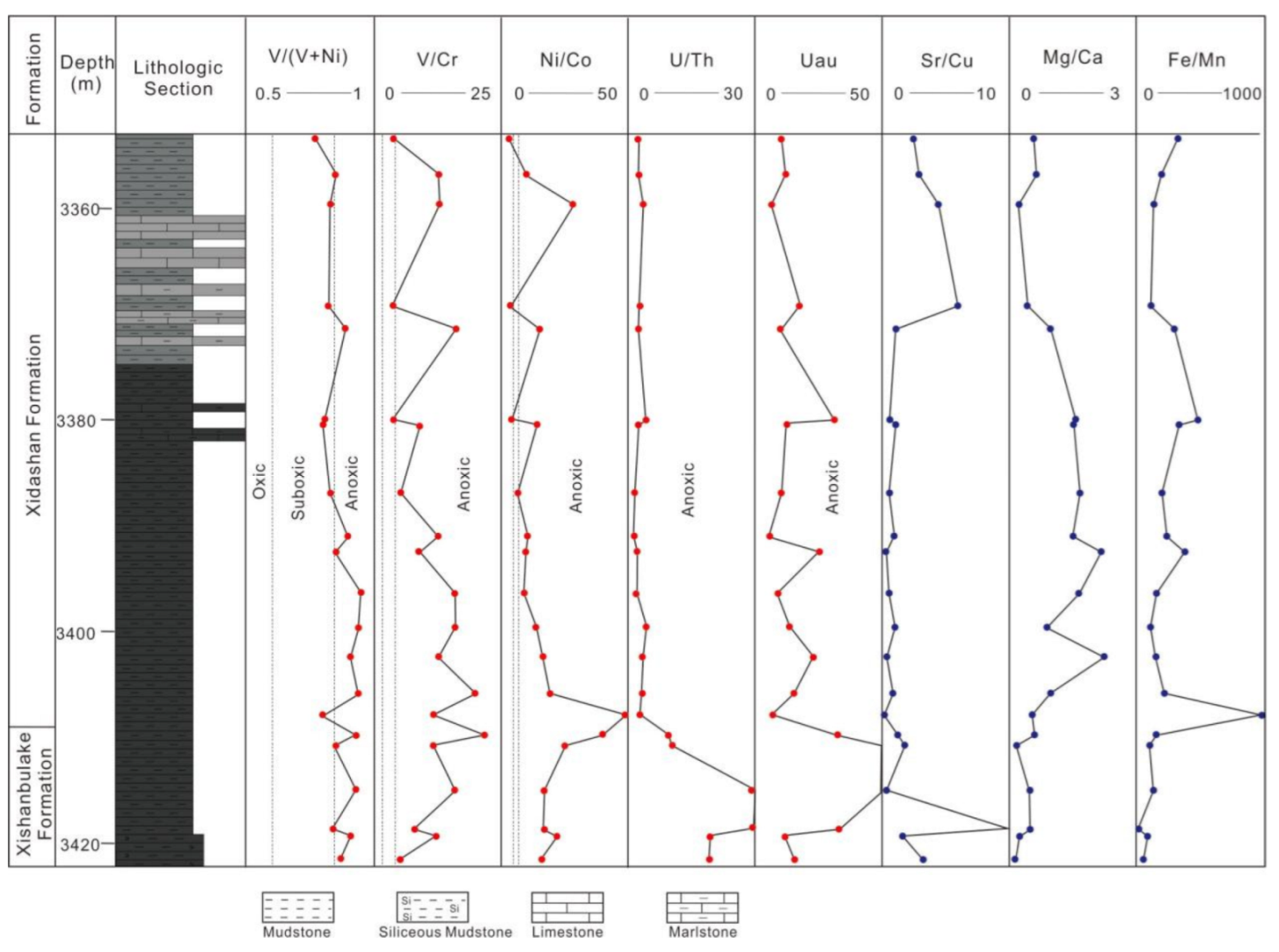
5.2. Paleoweathering Conditions
5.3. Provenance and Tectonic Settings
5.3.1. Paleoweathering Conditions

5.3.2. Provenance
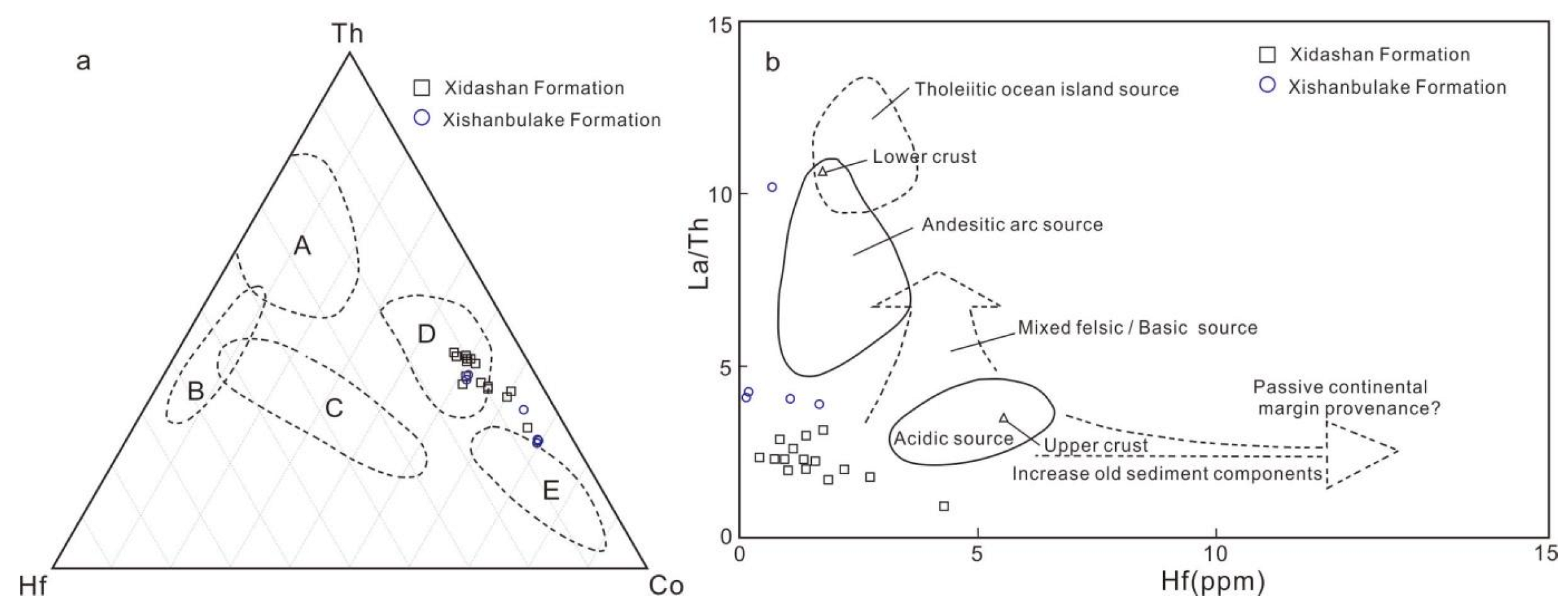
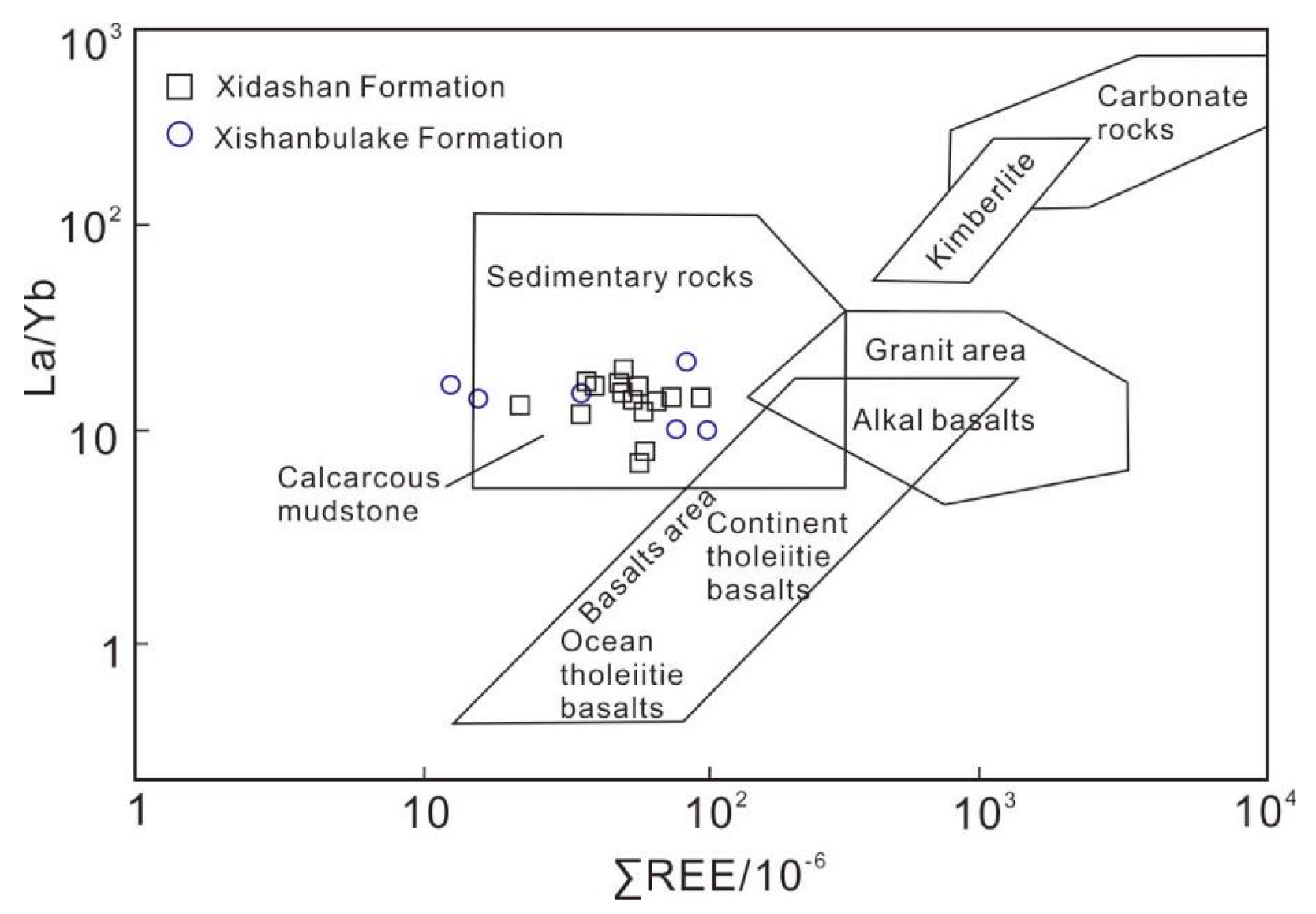
5.3.3. Tectonic Setting
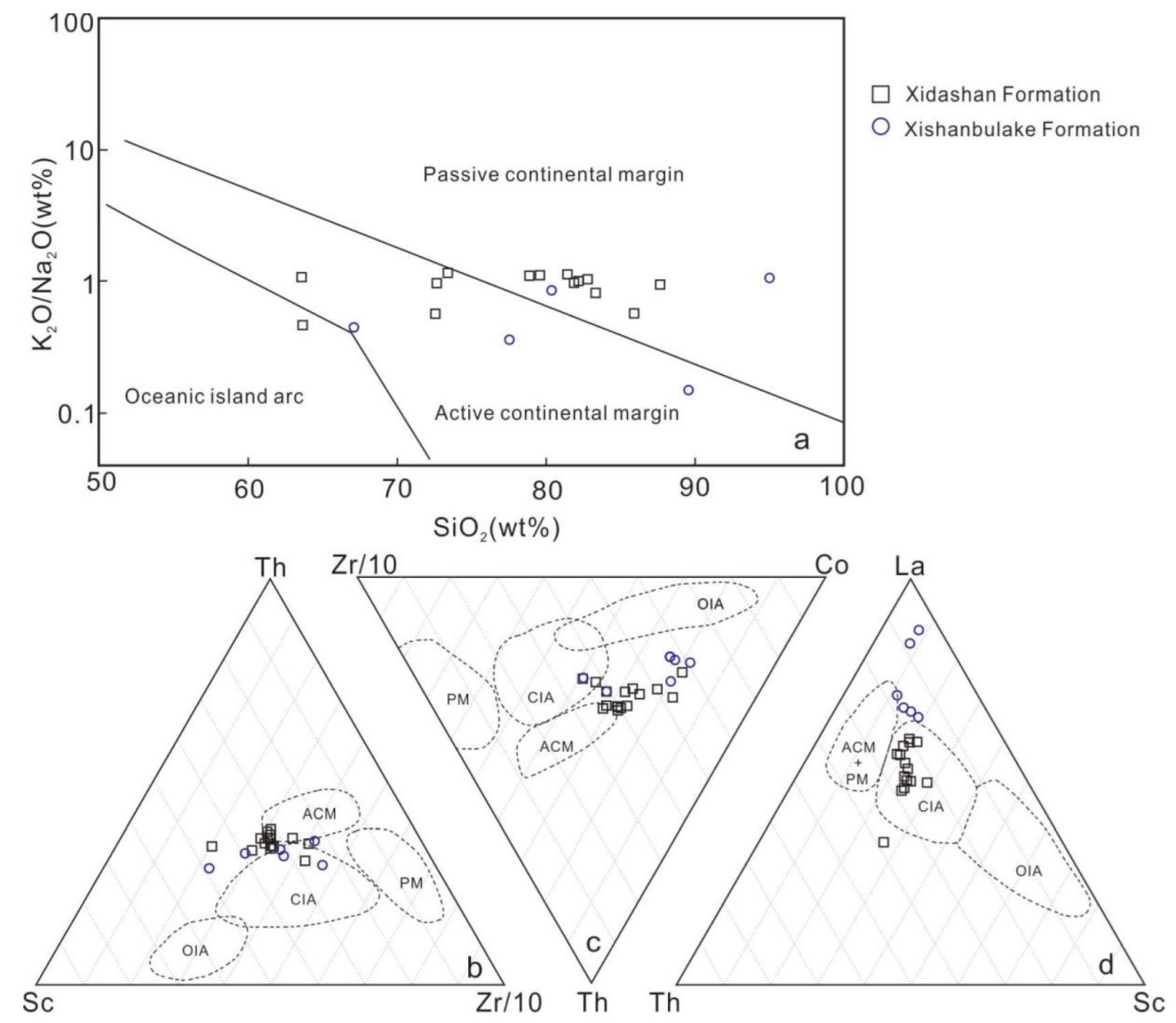
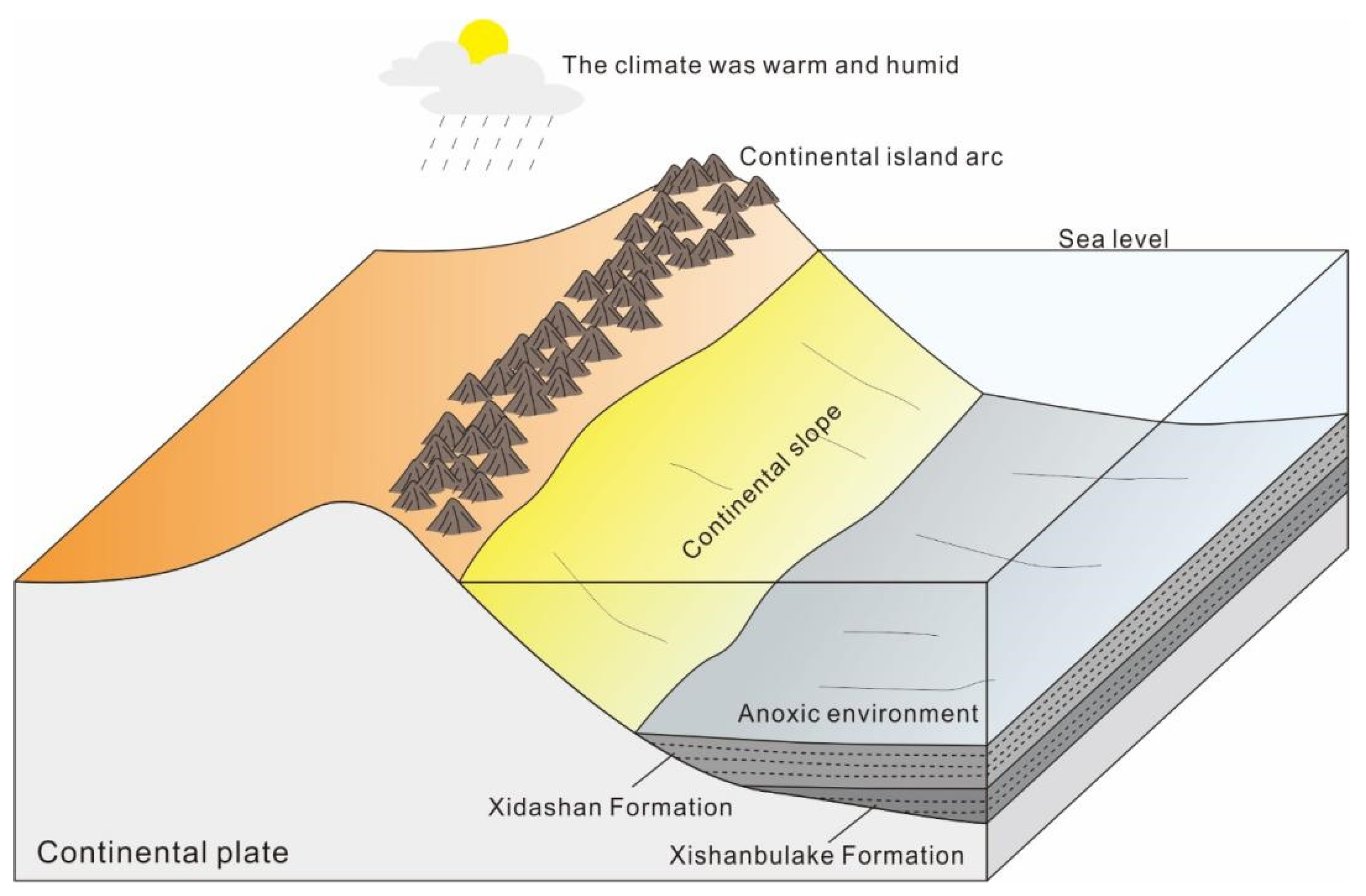
6. Conclusions
- (1)
- The redox indices of U, Uau, V/Cr, Ni/Co, and V/Sc indicate that most mudstone samples were formed in an anoxic sedimentary environment and that the reducing conditions weakened from the bottom to the top.
- (2)
- The Sr/Cu, Mg/Ca, and Fe/Mn ratios in the mudstone samples show that the sedimentation period of the Lower Cambrian was mainly characterized by a warm and humid paleoclimate.
- (3)
- The comprehensive analysis of geochemical parameters, namely, CIA, PIA, and ICV values and Th/U and K/Rb ratios in the Lower Cambrian mudstone all reflect that the Lower Cambrian parent rock in the study area has mainly been subject to low- to medium-degree chemical weathering and that the weathering effect increases from the bottom to the top. The mudstone in the Xishanbulake and Xidashan Formations shares the same parent rock type, which is mainly sedimentary rock rich in felsic minerals. The tectonic setting of the Lower Cambrian mudstone is mainly a continental island arc environment, with characteristics of an ACM.
Author Contributions
Funding
Data Availability Statement
Conflicts of Interest
References
- Nesbitt, H.W.; Young, G.M. Early Proterozoic climates and plate motions inferred from major element chemistry of lutites. Nature 1982, 299, 715–717. [Google Scholar] [CrossRef]
- Bhatia, M.R. Rare earth element geochemistry of Australian Paleozoic graywackes and mud rocks: Provenance and tectonic control. Sediment. Geol. 1985, 45, 97–113. [Google Scholar] [CrossRef]
- Condie, K.C. Chemical composition and evolution of the upper continental crust: Contrasting results from surface samples and shales. Chem. Geol. 1993, 104, 1–37. [Google Scholar] [CrossRef]
- McLennan, S.M.; Hemming, S.; McDaniel, D.K.; Hanson, G.N. Geochemical approaches to sedimentation, provenance, and tectonics. Spec. Pap. (Geol. Soc. Am.) 1993, 284, 21–40. [Google Scholar]
- Wang, C.; Wang, Q.; Chen, G.; He, L.; Xu, Y.; Chen, L.; Chen, D. Petrographic and geochemical characteristics of the lacustrine black shales from the Upper Triassic Yanchang Formation of the Ordos Basin, China: Implications for the organic matter accumulation. Mar. Pet. Geol. 2017, 86, 52–65. [Google Scholar] [CrossRef]
- Xie, G.; Shen, Y.; Liu, S.; Hao, W. Trace and rare earth element (REE) characteristics of mudstones from Eocene Pinghu Formation and Oligocene Huagang Formation in Xihu Sag, East China Sea Basin: Implications for provenance, depositional conditions and paleoclimate. Mar. Pet. Geol. 2018, 92, 20–36. [Google Scholar] [CrossRef]
- Xu, J.; Xia, X.; Huang, C.; Cai, K.; Yin, C.; Lai, C.-K. Changes of provenance of Permian and Triassic sedimentary rocks from the Ailaoshan suture zone (SW China) with implications for the closure of the eastern Paleotethys. J. Asian Earth Sci. 2019, 170, 234–248. [Google Scholar] [CrossRef]
- Lin, X.; Zhang, Z.K.; Liu, X.; Chen, N.; Wu, T.; Zhang, Y.; Zhao, P.; Ma, X.; Zhou, Z. Geochemical characteristics of Late Triassic sandstones in the western part of Bayan Har Basin, Northern Tibetan Plateau, Western China: Constraints on provenance, source weathering, tectonic setting, and palaeoenvironment. Geol. J. 2020, 55, 5275–5293. [Google Scholar] [CrossRef]
- Li, J.; Tian, J.; Zhang, X.; Liang, Q.; Peng, M. Geochemical characteristics and the constraints on paleoenvironment, provenance, and tectonic setting of Precambrian Xifangshan Formation in the northwestern Tarim Basin, NW China. J. Pet. Sci. Eng. 2022, 208, 109553. [Google Scholar] [CrossRef]
- Xu, Z.-Q.; He, B.-Z.; Zhang, C.-L.; Zhang, J.-X.; Wang, Z.-M.; Cai, Z.-H. Tectonic framework and crustal evolution of the Precambrian basement of the Tarim Block in NW China: New geochronological evidence from deep drilling samples. Precambrian Res. 2013, 235, 150–162. [Google Scholar] [CrossRef]
- Zhu, G.-Y.; Ren, R.; Chen, F.-R.; Li, T.-T.; Chen, Y.-Q. Neoproterozoic rift basins and their control on the development of hydrocarbon source rocks in the Tarim Basin, NW China. J. Asian Earth Sci. 2017, 150, 63–72. [Google Scholar] [CrossRef]
- Zhou, C.; Jiang, S. Palaeoceanographic redox environments for the lower Cambrian Hetang Formation in South China: Evidence from pyrite framboids, redox sensitive trace elements, and sponge biota occurrence. Palaeogeogr. Palaeoclimatol. Palaeoecol. 2009, 271, 279–286. [Google Scholar] [CrossRef]
- Gao, Z.; Fan, T. Carbonate platform-margin architecture and its influence on Cambrian-Ordovician reef-shoal development, Tarim Basin, NW China. Mar. Pet. Geol. 2015, 68, 291–306. [Google Scholar] [CrossRef]
- Yao, J.; Xiao, S.; Yin, L.; Li, G.; Yuan, X. Basal Cambrian microfossils from the Yurtus and Xishanblaq formations (Tarim, north-west China): Systematic revision and biostratigraphic correlation of Micrhystridium-like acritarchs. Palaeontology 2005, 48, 687–708. [Google Scholar] [CrossRef]
- Yao, C.; Ding, H.; Ma, D.; Li, G. Carbon isotope features of the Sugetbrak Section in the Aksu-Wushi Area, Northwest China: Implications for the Precambrian/Cambrian Stratigraphic Correlations. Acta Geol. Sin. 2014, 88, 1535–1546. [Google Scholar] [CrossRef]
- Jones, B.; Manning, D.A.C. Comparison of geochemical indices used for the interpretation of palaeoredox conditions in ancient mudstones. Chem. Geol. 1994, 111, 111–129. [Google Scholar] [CrossRef]
- Algeo, T.J.; Maynard, J.B. Trace-element behavior and redox facies in core shales of Upper Pennsylvanian Kansas-type cyclothems. Chem. Geol. 2004, 206, 289–318. [Google Scholar] [CrossRef]
- Calvert, S.E.; Pedersen, T.F. Geochemistry of Recent oxic and anoxic marine sediments: Implications for the geological record. Mar. Geol. 1993, 113, 67–88. [Google Scholar] [CrossRef]
- Bjorlykke, K. Depositional History and Geochemical Composition of Lower Palaeozoic Epicontinental Sediments from the Oslo Region; Bulletin (Norges geologiske undersøkelse: 1984); Universitetsforlaget: Trondheim, Norway, 1974. [Google Scholar]
- Wignall, P.B.; Twitchett, R.J. Oceanic Anoxia and the End Permian Mass Extinction. Science. Science 1996, 272, 1155–1158. [Google Scholar] [CrossRef]
- Kimura, H.; Watanabe, Y. Ocean anoxia at the Precambrian-Cambrian boundary. Geology 2001, 29, 995–998. [Google Scholar] [CrossRef]
- Hu, J.; Li, Q.; Li, J.; Huang, J.; Ge, D. Geochemical characteristics and depositional environment of the Middle Permian mudstones from central Qiangtang Basin, northern Tibet. Geol. J. 2016, 51, 560–571. [Google Scholar] [CrossRef]
- Wignall, P.B.; Myers, K.J. Interpreting the benthic oxygen levels in mudrocks, a new Interpreting the benthic oxygen levels in mudrocks, a new Interpreting the benthic oxygen levels in mudrocks, a new approach. Geology 1988, 16, 452–455. [Google Scholar] [CrossRef]
- Lerman, A. (Ed.) Lakes-Chemistry. In Geology, Physics; Springer: Berlin/Heidelberg, Germany; New York, NY, USA, 1978. [Google Scholar]
- Xu, Q.; Liu, B.; Ma, Y.; Song, X.; Wang, Y.; Chen, Z. Geological and geochemical characterization of lacustrine shale: A case study of the Jurassic Da’anzhai member shale in the central Sichuan Basin, southwest China. J. Nat. Gas Sci. Eng. 2017, 47, 124–139. [Google Scholar] [CrossRef]
- Ferguson, J.; Henderson, G.; Kucera, M.; Rickaby, R. Systematic change of foraminiferal Mg/Ca ratios across a strong salinity gradient. Earth Planet. Sci. Lett. 2008, 265, 153–166. [Google Scholar] [CrossRef] [Green Version]
- Shaw, T.; Raiswell, R.; Hexel, C.; Vu, H.; Moore, W.; Dudgeon, R.; Smith, K. Input, composition, and potential impact of terrigenous material from free-drifting icebergs in the Weddell Sea. Deep. Sea Res. Part II Top. Stud. Oceanogr. 2011, 58, 1376–1383. [Google Scholar] [CrossRef]
- Cox, R.; Lowe, D.R.; Cullers, R.L. The influence of sediment recycling and basement composition on evolution of mudrock chemistry in Southwestern United States. Geochim. Cosmochim. Acta 1995, 59, 2919–2940. [Google Scholar] [CrossRef]
- Cullers, R.L.; Berendsen, P. The provenance and chemical variation of sandstones associated with the Mid-continent Rift System. Eur. J. Mineral. 1998, 10, 987–1102. [Google Scholar] [CrossRef]
- Armstrong-Altrin, J.S.; Lee, Y.I.; Verma, S.P.; Ramasamy, S. Geochemistry of sandstones from the upper Miocene Kudankulam Formation, southern India; implications for provenance, weathering, and tectonic setting. J. Sediment. Res. 2004, 74, 285–297. [Google Scholar] [CrossRef]
- McLennan, S.; Hemming, S.; Taylor, S.; Eriksson, K. Early Proterozoic crustal evolution; Geochemical and Nd-Pb isotopic evidence from metasedimentary rocks, southwestern North America. Geochim. Cosmochim. Acta 1995, 59, 1153–1177. [Google Scholar] [CrossRef]
- Cullers, R.L.; Podkovyrov, V.N. The source and origin of terrigenous sedimentary rocks in the Mesoproterozoic Ui group, southeastern Russia. Precambrian Res. 2002, 117, 157–183. [Google Scholar] [CrossRef]
- Wronkiewicz, D.J.; Condie, K.C. Geochemistry and mineralogy of sediments from the Ventersdorp and Transvaal supergroups, South Africa; cratonic evolution during the early Proterozoic. Geochim. Cosmochim. Acta 1990, 54, 343–354. [Google Scholar] [CrossRef]
- Taylor, S.R.; McLennan, S.M. The Continental Crust: Its Composition and Evolution; Blackwell Scientific Publications: Oxford, UK, 1985; pp. 1–312. [Google Scholar]
- Floyd, P.A.; Leveridge, B.E. Tectonic environment of the Devonian Gramscatho basin, south Cornwall: Framework mode and geochemical evidence from turbiditic sandstones. Geol. Soc. 1987, 144, 531–542. [Google Scholar] [CrossRef]
- Allègre, C.; Michard, G. Introduction to Geochemistry. Geophysics and Astrophysics Monographs v. 10; Reidel Publishing Company: Boston, UK, 1974; 143p. [Google Scholar]
- Roser, B.P.; Korsch, R.J. Determination of tectonic setting of sandstone-mudstone suites using silica content and potassium oxide/sodium oxide ratio. J. Geol. 1986, 94, 635–650. [Google Scholar] [CrossRef]
- Bhatia, M.R.; Crook, K.A.W. Trace element characteristics of graywackes and tectonic setting discrimination of sedimentary basins. Contrib. Mineral. Petrol. 1986, 92, 181–193. [Google Scholar] [CrossRef]
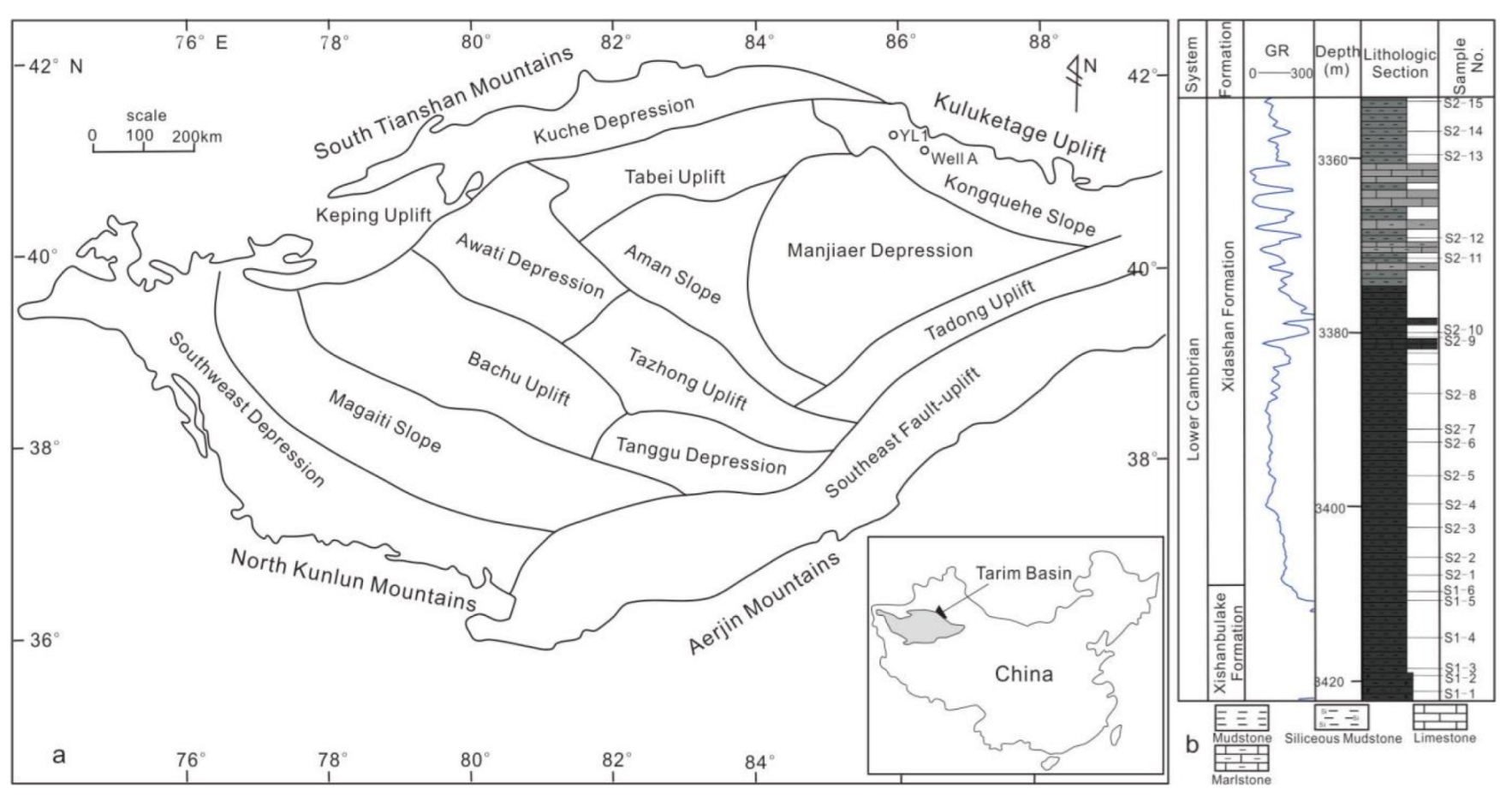
| Ratios | OC | LUC | UCC | Xidashan Formation | Xishanbulake Formation |
|---|---|---|---|---|---|
| Th/Co | 0.01 | 0.03 | 1.07 | 0.72 | 0.50 |
| La/Sc | 0.10 | 0.30 | 2.70 | 2.41 | 6.75 |
| Th/Sc | 0.94 | 0.03 | 0.97 | 1.10 | 1.05 |
| Th/Cr | 0.00 | 0.01 | 0.31 | 0.10 | 0.03 |
Publisher’s Note: MDPI stays neutral with regard to jurisdictional claims in published maps and institutional affiliations. |
© 2022 by the authors. Licensee MDPI, Basel, Switzerland. This article is an open access article distributed under the terms and conditions of the Creative Commons Attribution (CC BY) license (https://creativecommons.org/licenses/by/4.0/).
Share and Cite
Shang, K.; Tian, J.; Lv, H.; Zhang, X.; Li, J.; Zhang, Y. Geochemical Characteristics and the Sedimentary Environment of Lower Cambrian Argillaceous Rocks on the Kongquehe Slope, Tarim Basin, China. Energies 2022, 15, 5400. https://doi.org/10.3390/en15155400
Shang K, Tian J, Lv H, Zhang X, Li J, Zhang Y. Geochemical Characteristics and the Sedimentary Environment of Lower Cambrian Argillaceous Rocks on the Kongquehe Slope, Tarim Basin, China. Energies. 2022; 15(15):5400. https://doi.org/10.3390/en15155400
Chicago/Turabian StyleShang, Kai, Jingchun Tian, Haitao Lv, Xiang Zhang, Jian Li, and Yue Zhang. 2022. "Geochemical Characteristics and the Sedimentary Environment of Lower Cambrian Argillaceous Rocks on the Kongquehe Slope, Tarim Basin, China" Energies 15, no. 15: 5400. https://doi.org/10.3390/en15155400
APA StyleShang, K., Tian, J., Lv, H., Zhang, X., Li, J., & Zhang, Y. (2022). Geochemical Characteristics and the Sedimentary Environment of Lower Cambrian Argillaceous Rocks on the Kongquehe Slope, Tarim Basin, China. Energies, 15(15), 5400. https://doi.org/10.3390/en15155400






